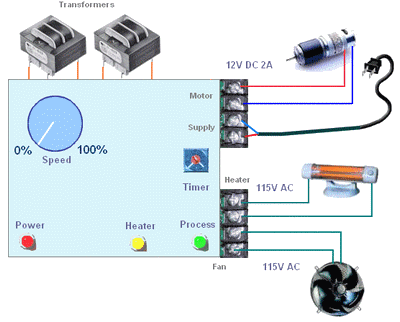Analog Op-Amp Circuits

he very first designs that came about were analog designs, a Vacuum Tube amplifier is an example. Analog is the representation of data or physical parameter in an accurate and precise decimal number like +72.182 mV. The greater the resolution required, the more demanding is the design for achieving high accuracy and low drift.
As an analogy, see the conventional water tap as an analog control, an electric light ON-OFF switch as a digital control. After the handheld Abacus calculator (low-power, durable, bio-degradable), Mechanical and electro-mechanical computers were made and studied, The very first electronic computers were Analog Computers using an opamp as a building block.
Operational Amplifiers
With a few Op-Amps and a regulated Power supply, many Instrumentation and Process control equipment can be designed. The Human Brain understands Numbers, Quantity and it regulation very well ! On the right you can see a analog controller based on opamps and discrete devices. A Heater, Fan and Motor is regulated, controlled and timed for a process.

Analog is about numbers, the circuits can be understood and designed mathematically or empirically. Designing and Building a True RMS Rectifier with Op-Amps, will help a designer digest many Op-Amp capabilities.
Things you ought to know about Op-Amps –
OpAmp part numbers from various semiconductor companies are designed for both General purpose and special applications. Some have to be cost-effective for consumer low-cost equipment, while others may be advanced in specs, closing in on an ideal Op-Amp.
Instrumentation opamps are used for accurate and low drift applications. These Op-Amps have stringent specifications and are used in the fields like Aerospace or Medical Electronics. A pre-amplifier for an FM Radio may need to be low-priced. Test Measurement needs Op-Amps which have near ideal specs in the area of measurement or application. CMOS low-power devices are used when designs are made for portable gadgets.
- Outputs cannot be Loaded beyond the drive capacities, Note Resistors and Output Load.
- Inputs draw a small bias current and will load the signal sources, compensate design.
- Op-Ams AF-RF or Switching performance study with Slew rate and Bandwidth.
- Power consumption of some Op-Amps are more and some very less, choose wisely.
- Look for Standard Pin-Outs, Price, Popularity and study Abs. Max, AC and DC Specs.
- Use Packages with multiple Op-Amps like LM324 to save board space and assembly time.
- Op-Amps and its 1% MFR resistors should have a separate supply and far from hot parts.
- Ultra Low Offset Voltage is required, when you wish to amplify a DC level of say 500uV.
- Guard rings to be used for High impedance inputs and EMI-RFI Shielding for AF Amplifiers.
- Glass epoxy PCB, clean surface, Pins and Tracks protected from Moisture and Chemicals.
- Avoid Ground Loops, Have regulated Low ripple Power supplies. Dynamic Isolation.
First Read
Op Amps for Everyone by Ron Mancini
LM335 and LM336 –
LM335 is a temp sensor, LM335 . use it for temp for CJC. Temperature Sensors – RTDs and Thermocouples in Temperature Measurement.
LM336-2.5 is an voltage Reference. recision 2.5V shunt regulator diodes, Applied as a precision 2.5V low voltage reference for digital voltmeters, power supplies or in opamp signal conditioning.
Current Loop –
4-20 ma will drive DC drives, motors and steam valves. It is a current loop, for long distance transmission, current loop is not prone to noise and hum, EMI RFI. As it is a small power transmission no loss of data, also many equipments can be in one data loop. A single transmitter with 4-20mA out can drive a strip-chart recorder, motor, controller and SCADA input. all in a series loop. Current loop is like 4-20 mA
Opamp Notes and Types
- TL062, LF353, TL072, fet input. 1 tera ohm input imp.
- OP07 higher price, 1 giga ohm. 75uV offset.
- LF353 pin to pin replacement of TL062-72 and 82.
- LM358 works on single supply too, low price, inp imp 1 meg.
- LM324 Quad, works of batteries well.
- All work best with dual +/- 5 V or more. LM7805 -LM 7905.
Points to Note –
- Analog ground (opamps), digital ground (CMOS) and power ground (relays and LED) should be separate, (linked at root)
- Glass epoxy PCB have high insulation resistance, above 10 tera ohms, and are not hygroscopic which means they do not drink water vapor, this makes them very suitable for precision instrumentation and sensitive circuits.
- When you measure DC levels in 16bit accuracy or more you need resistors which have temp. coeff. of 10ppm, or you may have to put the entire circuit in a stable 45 deg oven. Thermoelectric effects, EMI, RFI, pA Leakage currents, ground loops, contact resistance all can make the readings drift and unusable.
- High impedance points of circuit like 500 kilo ohm and above can pick up AC noise and DC leakage currents. this will affect the performance of circuit, so for DC you have to put a guard ring of the signal ground around that point in PCB. For RF you have to shield with things related to iron and mu metal, for low signals even a copper shield will do.
- Percentage and ppm: when percentage becomes like 0.001% it is difficult to manage, so we use ppm-parts per million.5% means 5 parts in 100 parts. 23 ppm means 23 parts per million parts. 0.001% – shift the dp-decimal point four places to right it is 10ppm. 0.01% is 100ppm which is the variation of value of mfr resistors on temperature change.
delabs design notes from 90s to 2005
Learn this at my Industrial Process Control Circuit


